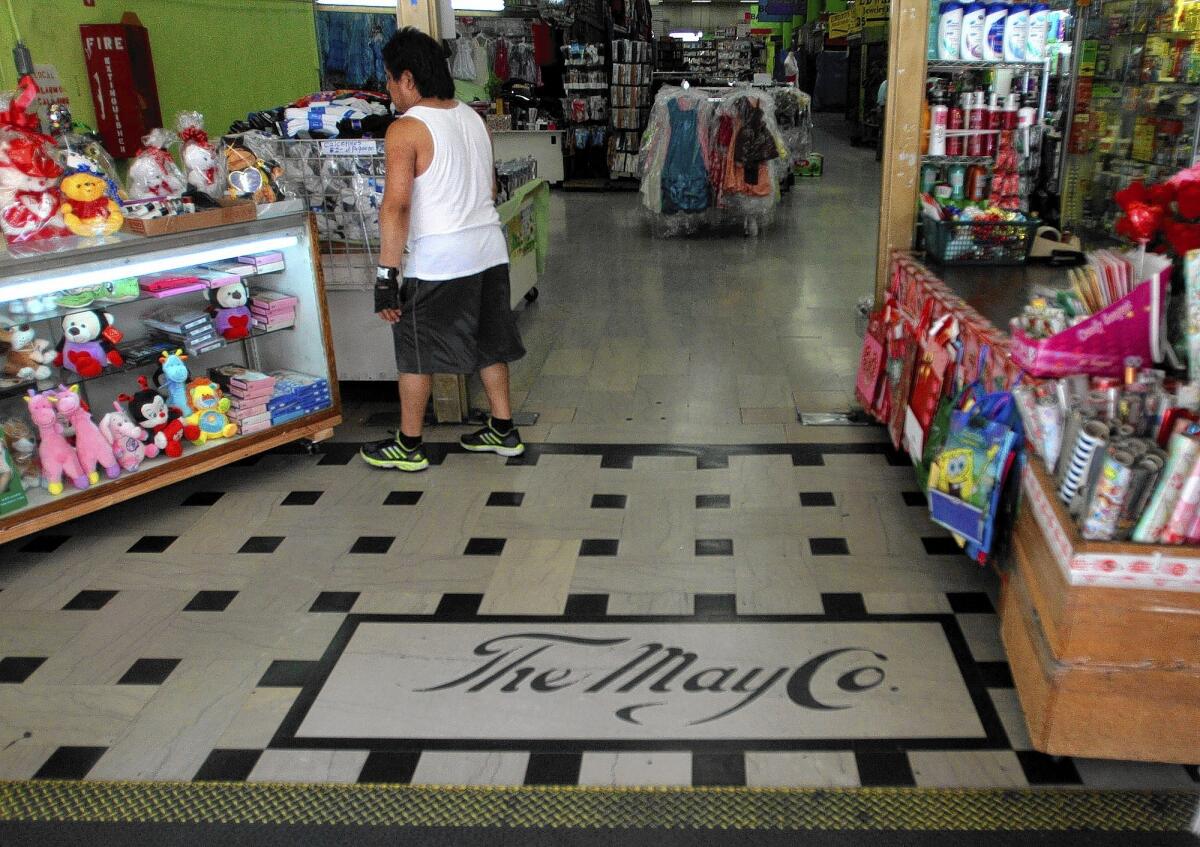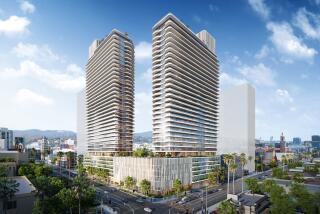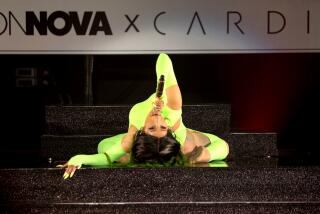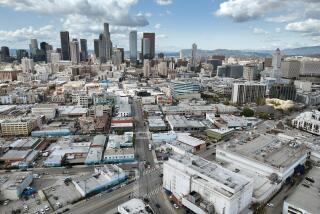Former May Co. building in downtown L.A. is sold for $130 million

A huge, run-down former department store on Broadway in downtown Los Angeles has been acquired for about $130 million by New York investors who intend to bring the old May Co. flagship back to prominence as a shopping and office complex.
Many old buildings have been renovated during downtown’s renaissance over the last several years. But at almost 1.1 million square feet the May Co. building, now known as the Broadway Trade Center, is a whale among minnows.
If it can attract the tenants its new owners want, the complex would become one of the largest single tech centers in the country.
“They’re building a creative campus using the high-end Chelsea Market in New York as design inspiration,” real estate broker Phillip Sample of CBRE Group Inc. said.
Chelsea Market was built in the husk of a sprawling brick 19th century factory and is now a successful food sales hall, shopping mall, office building and television production facility. The nine-story May Co. building at Broadway and 8th Street in Los Angeles is considered one of the largest properties available for a similar conversion on the West Coast.
It was purchased by Waterbridge Capital and New York real estate developer Jack Jangana from Beverly Hills investors. Terms of the sale were not disclosed, but people familiar with downtown real estate valued the deal at about $130 million. Renovating the building could cost that much or more.
Waterbridge Capital declined to comment on the sale and Jangana could not be reached. Both have track records of acquiring older urban properties and improving them. The New York investors have worked together in the past.
Their goal in Los Angeles, according to real estate experts familiar with the property, is to devote the first two floors to retail uses. At 230,000 square feet, the portion for stores and restaurants would be about the size of a typical neighborhood shopping center.
The developers hope to land a major tech tenant that would rent about 300,000 square feet upstairs and help attract other tech-related tenants.
“The new owner plans to build a creative campus, which will be ready in about 24 months for a major tech tenant to move in,” said Chris Caras, a CBRE broker who also worked on the deal. He compared it to social media giant Twitter’s headquarters in a historic building in San Francisco.
Downtown Los Angeles has historically been a citadel of white-collar corporate America, the home of bankers, lawyers and accountants. Tech and so-called creative firms have clustered in other office markets such as Santa Monica, Playa Vista and Hollywood.
In recent years, however, an increasing number of creative firms have found their way downtown and landlords are scrambling to attract more of them. Creative businesses have shown a preference for restored industrial buildings such as those found in the Arts District and historic office properties such as the PacMutual complex next to Pershing Square.
The arrival of a big tech firm in the reviving neighborhood of Broadway, Main and Spring streets would inject well-paying jobs to an area that has been mostly elevated by new residences, bars and restaurants.
But tech may not be enough to fill the gigantic Broadway Trade Center, which now has inexpensive retail stalls and restaurants on the first floor and garment-making businesses upstairs. Urban planners have suggested that the old department store has enough room to add other uses such as apartments or a hotel in addition to offices and shops.
Historically, however, the beaux-arts structure has been many things simultaneously. It opened in 1908 as the Hamburger department store; in addition to selling clothing and home furnishings, it had an 80-foot-long soda fountain, a restaurant, a grocery store, a post office and a roof garden. The third floor housed the L.A. Public Library for a few years.
There was a house physician’s office with a fully equipped operating room ready for emergencies “and a corner where a fainting woman can rest and be restored to strength,” The Times reported at the time. There was also a theater where an audience of 1,000 could watch a moving-picture show or a vaudeville act.
The department store grew even bigger after its 1923 purchase by the May Co., a St. Louis department store chain that went on to build many Southern California locations. Among the downtown additions by May Co. was a nine-story tower connected to the original five-story structure and a stately garage at 9th and Hill streets that was one of the nation’s first parking structures when it opened in 1926.
The May Co. building “is a critical piece of the revitalization puzzle,” Los Angeles City Councilman Jose Huizar said before the sale. “We are committed to working with the future owner to ensure this historic property is as important to our city’s future as it is to our past.”
Twitter: @rogervincent
More to Read
Sign up for Essential California
The most important California stories and recommendations in your inbox every morning.
You may occasionally receive promotional content from the Los Angeles Times.







